The Kelvingrove Art Gallery and Museum is located in one of the most beautiful green spaces of Glasgow… the Kelvingrove Park. Though the medieval Victorian-style sandstone brick façade of the Kelvingrove Art gallery is stunning, it’s no match for the astounding treasures that are housed inside. Rembrandts and Renoirs and the best work of the best Scottish artists jostle for space inside. There are old armour displays and ancient Egyptian treasures that will stun the onlookers.
An entire fighter plane hangs from its ceilings while dinosaur models pose in Victorian display spaces. The façade itself will charm your camera and you won’t be able to stop taking pictures… its huge entrance, a profusion of turrets and towers and immaculate detailing are infinitely charming.
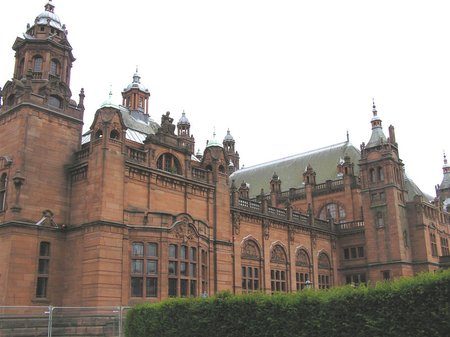
History
The proceeds (about 250,000 pounds) from the 1888 International exhibition and public subscriptions helped gather funds for the construction of the Kelvingrove gallery that dates back to 1901. The original collections of the gallery came from the Mclellan Galleries and the City Industrial Museum.
The Kelvingrove is now hailed as one of the most beautiful buildings in Glasgow but back then it was criticised for ostentatiousness and its English style windows. Some say that the building was constructed back to front by mistake and the architect jumped to his death when he realised his mistake. The building is inspired by many styles… the dominant theme being Hispanic Baroque. The north front is inspired by the Cathedral of Santiago de Compostela. The vivid colour scheme and fairy tale towers blend in beautifully with the foliage of Kelvingrove Park and create a magical picturesque effect.
The Kelvingrove art gallery and museum was closed from 2003 to 11 July 2006 for restoration work. The restoration project cost 27.9 million pounds and it was a joint effort by the Glasgow City Council, European Regional development Society, Historic Scotland and some private donations. Her Majesty Queen Elizabeth II reopened the gallery on 11th July 2006 and it immediately became the most popular free to visit attraction of Scotland. During the restoration, a big new restaurant and a basement display space were added (35% more exhibition space was added in total). The total number of exhibits was also increased to 8,000 from 5,000.
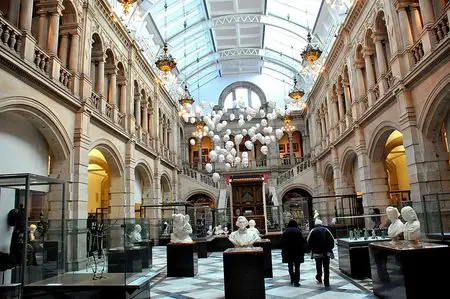
What To See & Do
The Kelvingrove art gallery and museum has 22 themed galleries, the most significant of which are:
Dutch Old Masters and French Impressionists
This gallery includes one of the largest and finest collections of 17th century Dutch and Flemish art in the UK and one of the most important collections of 19th-century French oils in the UK. French impressionists featured here include Claude Monet, Camille Pissarro, Pierre Renoir, Van Gogh and Mary Cassatt. Some old Masters featured here include Rembrandt van Rijn, Jozef Israel’s and Gerard de Lairesse.
Scottish Art Galleries
These are dedicated to the Glasgow Boys and Scottish Colourists. For the record, the term Glasgow Boys refers to 5 painters (Crawhall, Guthrie, Hornel, Lavery, Henry) who went against the traditional sentimental conservatism of 18th-century art and brought in a fresher newer style. The painters were all active proponents of the Glasgow School of Art.
Look out for ‘a Highland funeral’ by James Guthrie, Japanese lady with Fan by George Henry and the amazingly realistic watercolours by Crawhall. The Colourists again refers to a group of painters… namely Samuel Peploe, JD Fergusson, George Leslie Hunter and Francis Cadell who formed a loose group. The work of the ‘Scottish Colourists’ focuses intensely on colour manipulation and was once the toast of the Scottish high society. Some of the work to look out for here are The Orange Blind by FCB Cadell, J D Fergusson’s Grey Day, Roses by S J Peploe etc.
Salvador Dali’s Christ of St John of the Cross
Undoubtedly the star of this museum (it has an entire room to itself), the 1951 dated painting was bought in 1952 by the Museum director of those times Dr Ton Honeymon. A lot of controversies surrounded this purchase which cost a whopping 8,200 euros. More than 65 years have passed and the painting’s beauty has not diminished. You will be startled to see that Jesus on the cross in this painting is devoid of the marks of crucifixion. He looks down on the shoreline and some fishermen… the painting has a deeply spiritual yet startling effect.
Charles Rennie Mackintosh and the Glasgow Style
A gallery dedicated to Charles Rennie Mackintosh, Glasgow’s most famous personality, and the style movement which was Britain’s only response to the Art Nouveau wave that was sweeping the world. Mackintosh has worked with prints, architecture, design and textile art, and some of his best work is represented in this gallery. Look out for his huge and striking posters and his iconic high-backed chairs which went on to dominate some of Glasgow’s most famous tearooms.
Incidentally, the Glasgow School of Art wholeheartedly supported the design revolution incepted by Mackintosh and encouraged other designers especially female talent (a rarity in those times) to sharpen and showcase their work. Expect to see a stunning array of art forms here including books, metalwork, furniture, textiles, stencilling, textile work, posters, stained glass, ceramics glass, mosaic interior and architectural design. The reconstructed Ladies Luncheon Room and the Ingram Street Tea Room light fittings are the most impressive exhibits here and they look straight out of a fashion décor magazine.
Natural History
This section focuses on rare fauna, dinosaurs and other prehistoric mammals. The Animal Gallery is a huge hit with kids… there are plenty of interesting activities here besides a good collection of stuffed animals. There is a small interactive room where they can open drawers and browse around shells and fossils. Kids can look through a microscope, play with eggs of dinosaurs and watch bees interacting in a hive.
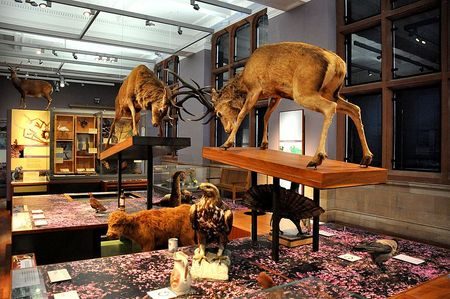
Then there is a room with tunnels and Scottish wildlife with a mini adventure theme. On the opposite side of the galleries from the animals, there are mounted faces with changing expressions. Another big hit with the kids is the rainforest experience which is basically an audio-visual walk through a black box. As you walk footage from a rainforest is played on screen and there are noises of thunderstorms plus simulated images of animals.
Arms and Armour
The Arms and Armour collection of the Kelvingrove is the largest in Britain and the exhibits span European medieval and renaissance exhibits. An INGELRII sword, Zweihanders, Stone Age weapons, Bronze Age knives are some of the best items to check out. Don’t miss a look at unusual stuff like a Micronesian textile armour with pufferfish helmet, Italian rapier fencing manuals and fetch butcher.
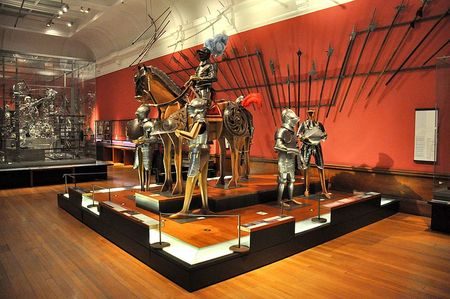
There is a separate area devoted to the Robert Lyons Scott collection which consists of more than 3,000 books and manuscripts that detail military theories, combat strategies and fencing plans. Unarmed combat, artillery, cavalry, hunting are just some other aspects of this huge collection (probably one of the 3 most important collections of this type globally). The collector RL Scott was a shipbuilder and a fencer. You might not be able to make much sense of the entire collection unless you are deeply interested in the subject. However, the more colourful exhibits like the Lichtenauer manuscript will surely strike you.
Ancient Egypt
This collection is of a lot of importance, featuring several objects of unique importance linked to historical figures. One fun thing here is a mummy that can be bandaged by visitors… kids especially find this activity interesting. The July 2006 reopening of the Kelvingrove came with some 82 extra exhibits in the Egyptian section that are a part of a long-term loan by the British Museum.
Scottish History and Archaeology
This includes an impressive array of material relating to the early settlements across Scotland and life on St Kilda across centuries. Visit this section only if you are interested in the history of Scotland.
World Cultures
This is like a socio-cultural summary of different continents and includes nationally and internationally important objects from the Americas, Africa, South Asia and Europe.
Decorative Arts
This section has a lot of work by Annie Hull Grundy who was a renowned art collector and philanthropist. This is a good way to know about the history of European jewellery in the 18th and 19th centuries.
West Wing
This part of the gallery has the famous spitfire i.e. an actual fighter plane that weighs 2.3 tonnes. This huge aircraft suspended from the ceiling in this grand Victorian setting has a startling effect. The plane was actually used in the 1940 Battle of Britain against the Nazis and has a Rolls Royce Griffon 61 engine plus a five-blade propeller. You can get a good view of the plane from the ground floor but there is a chance of some strain to your neck. For a more comfortable view step up to the first-floor mezzanine.
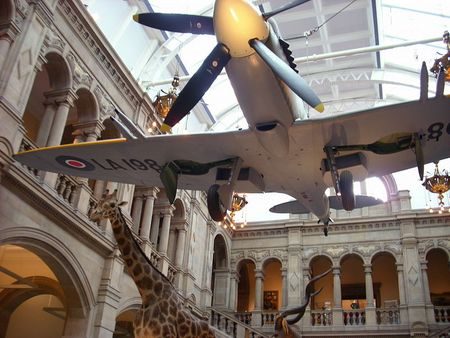
The plane was also used as a prop in the 1967 movie ‘Battle of Britain’. It was resting in the RAF museum storage before the Glasgow City Council brought it, restored and hung it up for display. Now it vividly reminds visitors of the daredevil pilots of World War II and is the museum’s favourite exhibit.
The Fulton’s Orrey
This is another unmissable exhibit… this is a 3d astronomical exhibit showing real-time positions of the solar system. The creator is Ayrshire based shoemaker John Fulton who later became an astronomer by choice and built amazingly detailed and creative planetary models. This exhibit is the best of his work.
The Coronation of the Virgin
This is a 4.5-meter-high 20-panel stained glass window collection that’s exquisitely pretty. The work is done by Irish artist Clarke and was commissioned in 1923 by Sisters of Notre Dame de Namur for the Glasgow convent chapel.
Sir Roger The elephant
This is another famous resident of the museum. This giant lifelike artificial elephant has been a part of the Kelvingrove for 100 years though he was intermittently a part of many travelling shows.
Centre Hall
The loveliest display of the museum is thought to be the concert Pipe Organ that was constructed and installed by Lewis Co. The commissioning of the organ was done in 1900 for the upcoming Glasgow international exhibition held in Kelvingrove Park. The organ was installed in the Centre Hall (then known as the Concert Hall) and a seating arrangement of 3,000 people was established. After the 1901 exhibition ended the Glasgow council east urged to buy and keep the organ as a part of the gallery. On most days there are organists playing that beautiful organ for half an hour from 1 p.m. onwards (weekdays) or 3 p.m. (Sundays).
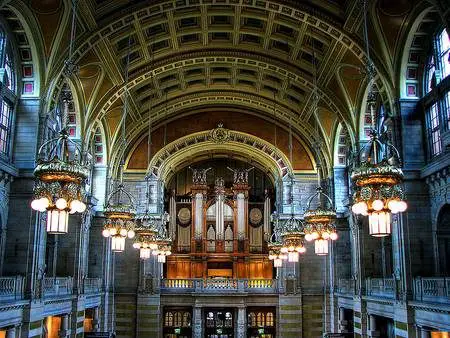
The Centre Hall is now a venue for receptions, fashion shows, product launches, dinners and banquets… about 500 guests can be accommodated inside for a dinner party. There is also a conference room on the lower ground floor that can seat 100. The East and West Balconies of Kelvingrove are also available for event hires and so is the in-house KG Café.
Drop into the Study Centre and Library to know more about the museum collections and access databases online.
Amenities
Events and exhibitions are a regular feature in the Kelvingrove gallery. Keep checking the official website to know the details of such events. Exhibits from other renowned museums also visit and stay for a while at the Kelvingrove while they are doing their world tours.
On the ground floor, there is the KG café with a decent selection of scones, cold drinks, cakes, sandwiches and hot drinks. They also rustle up cute lunch packs for kids.
In the basement, there is a spacious restaurant serving hot food along with Panini’s, sandwiches, salads and soups. The restaurant is pram friendly and visitors can be seen sitting and enjoying chat sessions.
Open Hours, Tours & Tickets
The Art gallery and Museum is open from 10.00 a.m. to 5.00 p.m. from Monday to Thursday and on Saturday. On Fridays and Sundays, the museum is open from 11 a.m. to 5.00 p.m. It is a free to visit attraction. Sometimes though there are temporary exhibitions and events at this venue that may require a small entry fee.
You can find several guided tours of The Kelvingrove Art Gallery and Museum (including tours combined with other attractions) and book online from this Viator site.
Location & Contacts
The Kelvingrove art gallery and Museum is located on Argyle Street in the city’s west end on the banks of the Kelvin River at the S-shaped end of the beautiful Kelvingrove Park. The nearest subway station is Kelvin hall from where the gallery is a 15-minute pretty walk through the park.
The Gallery is about 20 minutes of walk away from the Patrick station. The Bus service routes 3, 19, 19 A and 2 stop outside the Kelvingrove museum. The City Sightseeing bus tours also stop in front of the museum.
Right opposite the Kelvingrove Art Gallery is the Kelvin Hall that has a similar style of architecture. A notable attraction nearby is the University of Glasgow.
There is a big car park outside the gallery where they charge about 1 pound for 4 hours… this gets filled up pretty quickly. Metered on-street parking is available on Sauchiehall Street, Kelvin Way and the York hill area.
A number of cafes and pubs dot Argyle street like Little Café (Italian), Mother India Café (Indian), Green Chilli Café (Asian), Jay’s Grill Bar (Korean BBQ food), Brewdog Glasgow (pub and quick bites) and Baffo (pizza). If you feel like a hearty meal then the Butchershop Bar and Grill (Sauchiehall Street) has decent steaks while Elena’s Spanish Restaurant (Old Dumbarton Road) has good Mediterranean dishes.
Kelvingrove Art Gallery and Museum Argyle Street, Glasgow West End G3 8AG
Phone: +44 (0)141 276 9599
Email: [email protected]; Website
 A travel addict. Still celebrating the day when he quit his high-profile corporate job to pursue his passion for travel writing.
A travel addict. Still celebrating the day when he quit his high-profile corporate job to pursue his passion for travel writing.